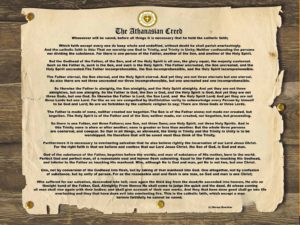No one is really sure who wrote the Athanasian Creed. There is also debate as to when and where it was composed. Some hold to the second half of the fourth century, others to the fifth century, and still others to the sixth century. A very few hold to the ninth century, though that is ridiculous as we have copies of the creed that predate that century. Some believe it was written in or around Alexandria, while others believe it was written in southern Gaul.
 This creed is named after St. Athanasius of Alexandria, a staunch defender of the Christian faith in the fourth century and does faithfully express his faith. A medieval account credited Athanasius as the author of the Creed. According to this account, Athanasius composed it during his exile in Rome, and presented it to Pope Julius I as a witness to his orthodoxy (sometime around 340). The Pope, by virtue of the creed, recognizes Athanasius as orthodox. The lateness of this story, along with other issues, makes it difficult to believe.
This creed is named after St. Athanasius of Alexandria, a staunch defender of the Christian faith in the fourth century and does faithfully express his faith. A medieval account credited Athanasius as the author of the Creed. According to this account, Athanasius composed it during his exile in Rome, and presented it to Pope Julius I as a witness to his orthodoxy (sometime around 340). The Pope, by virtue of the creed, recognizes Athanasius as orthodox. The lateness of this story, along with other issues, makes it difficult to believe.
Just about every “big gun” from the church’s history, from the late fourth through the ninth centuries, has been put forth as the composer of the Athanasian Creed, but all suggestions have a fatal flaw. If some major Church luminary was the author, then surely his name would have immediately been attached to the creed. This didn’t happen. Bottom line, we do not know who wrote the Athanasian Creed and so he is probably not a prominent figure in Church history.
The fact that it is being referred to by prominent Christian writers by the middle of the fifth century in southern Gaul is more than enough to reason to assume it was composed sometime in the latter half of the fourth or very early part of the fifth century. It was probably written by an obscure bishop for the congregations under his charge for use in their worship services. Though this bishop never made a name for himself in human history, the creed he wrote is a powerful testimony to the truth that there is no unimportant service (or servants) in Christ’s Kingdom.
In spite of the fact that this creed had spread far and wide, the Athanasian Creed does not receive “official” recognition until the Reformation. It was indorsed by the Lutherans in the Augsburg Confession (1530) and included in the Book of Concord (1580). The Roman Catholic Church endorsed it at the Council of Trent (1545-1563). It was also indorsed by most Protestant branches that sprung up during the Reformation period (Church of England, Reformed confessions, etc.).
The Latin name for the Athanasian Creed is “Quicumque vult,” which are the first two words of the creed in Latin. They translate “Whosoever wishes”. Though its contents appear to focus on teaching to contemporary readers, its opening actually sets out the essential principle that the Christian faith does not consist in the first place in assent to propositions, but “that we worship One God in Trinity, and the Trinity in Unity”. All else in the creed, flows from that orientation. The two key elements of true worship in the creed is worship of the Triune God and of Jesus as both fully God and fully man. There are other elements included in the creed, but these two points are clearly the main focus. One key lesson we learn from this, then, is that what we do in worship is VERY important. A generic worship of God is not “good enough.”
Some are startled, even troubled, by the “damnatory”, or “minatory clauses”, in this creed (the penalties which follow the rejection of what is proposed for our worship and belief). In reality, they are but the creedal equivalent of Our Lord’s words: “Whoever believes in him is not condemned, but whoever does not believe is condemned already, because he has not believed in the name of the only Son of God. And this is the judgment: the light has come into the world, and people loved the darkness rather than the light because their works were evil” (John 3:18-19). Clearly these words of Jesus, and the creed, apply only to the culpable and willful rejection of Christ’s words and teachings. In other words, it is rejection of the truth once learned, not ignorance of the truth, that this creed (and Jesus) say are condemned.
This creed, as said above, has always been intended for use in worship. The congregation would either sing or recite it. During the Middle Ages it was used quite often; in some places in Europe, every week. In our age, with theology by sound bite, this rich creed is the most overlooked of the three ecumenical creeds. In some churches, it is never used. We use it once a year, on Trinity Sunday (the first Sunday after Pentecost). If we were wise, we would use it far more.
